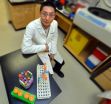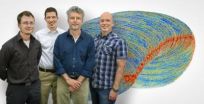(Press-News.org) MANHATTAN -- A Kansas State University research team has found that despite humans increasing nitrogen production through industrialization, nitrogen availability in many ecosystems has remained steady for the past 500 years. Their work appears in the journal Nature.
"People have been really interested in nitrogen in current times because it's a major pollutant," said Kendra McLauchlan, assistant professor of geography and director of the university's Paleoenvironmental Laboratory. "Humans are producing a lot more nitrogen than in the past for use as crop fertilizer, and there is concern because excess levels can cause damage. The mystery, though, is whether the biosphere is able to soak up this extra nitrogen and what that means for the future."
Nitrogen is a key component of the ecosystem and the largest regulator of plant growth. It determines how much food, fuel and fiber the land can produce. It also determines how much carbon dioxide plants remove from the atmosphere, and it interacts with several components of the climate system. Excessive amounts of nitrogen in ecosystems contribute to global warming and impairment of downstream ecosystems.
McLauchlan worked with Joseph Craine, research assistant professor in biology; Joseph Williams, postdoctoral research associate; and Elizabeth Jeffers, postdoctoral research associate at the University of Oxford. The team published their findings, "Changes in global nitrogen cycling during the Holocene epoch," in the current issue of Nature.
In the study the team also looked at how nitrogen availability changed thousands of years ago.
Roughly 15,000 years ago, the Earth began to warm, melting many glaciers and ice sheets that covered the landscape. Researchers found that Earth experienced an 8,000-year long decline in nitrogen availability as temperatures rose and carbon and nitrogen became locked up in soils. According to researchers, how the nitrogen cycle responded to these ancient global changes in carbon dioxide could be a glimpse into the future.
"What happened in the past might be a dry run for Earth's future," Craine said. "By looking at what happened millennia ago, we can see what controlled and prevented changes in nitrogen availability. This helps us understand and predict how things will change in the future."
The team collected and analyzed data from the sediment records of 86 lakes scattered across six continents. The lakes were distributed between tropical and temperate zones. With the data, the team was able to compare past and present cycling in various regions.
Researchers found that once most of the glaciers and ice sheets had melted around 11,000 years ago, the Earth continued to experience a global decline in nitrogen that lasted another 4,000 years.
"That was one of the really surprising findings," Craine said. "As the world was getting warmer and experiencing higher carbon dioxide levels than it had in the past, just like we are currently experiencing, the ecosystems were starting to lock carbon in the soils and in plants, also like we are seeing today. That created a long decline in nitrogen availability, and it scrubbed nitrogen out of the atmosphere."
McLauchlan said the most surprising finding, however, was that although humans have nearly doubled the amount of nitrogen to the ecosystems, globally nitrogen levels have remained stable at most sites for the past 500 years.
One reason may be that plants are using more nitrogen than they previously have, keeping nitrogen levels consistent with those thousands of years ago even though humans continue to add carbon dioxide and nitrogen to the atmosphere, McLauchlan said.
"Our best idea is that the nitrogen and carbon cycles were linked tightly back then and they are linked tightly today," McLauchlan said. "Humans are now manipulating both nitrogen and carbon at the same time, which means that there is no net effect on the biosphere."
The balance may be only temporary, McLauchlan said.
"Based on what we learned from the past, if the response of plants to elevated carbon dioxide slows, nitrogen availability is likely to increase and ecosystems will begin to change profoundly," McLauchlan said. "Now more than ever, it's important to begin monitoring our grasslands and forests for early warning signs."
###
The Nature study is an extension of McLauchlan's National Science Foundation CAREER Award that examines the history of nitrogen cycling in forested and grassland environments, her research on nitrogen concentrations and grasslands at the Konza Prairie Biological Station, and Craine's research on grasslands and climate change. END
Philadelphia, PA, March 21, 2013 – The April issue of Translational Research examines the progress and outlook of gene therapy research, with a specific focus on the clinical applicability of gene therapy today. Research articles included in the special issue highlight current studies that, after decades of trial and error, may provide evidence for a clear path of treatment and cure for many diseases. There are more than 1,800 genetic disorders known in humans, and only a small fraction of these can be treated and even fewer cured. Some of these disorders are exceedingly ...
University of Colorado Boulder astronomers targeting one of the brightest quasars glowing in the universe some 11 billion years ago say "sideline quasars" likely teamed up with it to heat abundant helium gas billions of years ago, preventing small galaxy formation.
CU-Boulder Professor Michael Shull and Research Associate David Syphers used the Hubble Space Telescope to look at the quasar -- the brilliant core of an active galaxy that acted as a "lighthouse" for the observations -- to better understand the conditions of the early universe. The scientists studied gaseous ...
Once rhesus monkeys learn to associate a picture with a reward, the reward by itself becomes enough to alter the activity in the monkeys' visual cortex. This finding was made by neurophysiologists Wim Vanduffel and John Arsenault (KU Leuven and Harvard Medical School) and American colleagues using functional brain scans and was published recently in the leading journal Neuron.
Our visual perception is not determined solely by retinal activity. Other factors also influence the processing of visual signals in the brain. "Selective attention is one such factor," says Professor ...
New Rochelle, NY, March 21, 2013—A new study of patterns of brain communication in toddlers with autism shows evidence of aberrant neural communication even at this relatively early stage of brain development. The results are presented in an article in Brain Connectivity, a bimonthly peer-reviewed journal from Mary Ann Liebert, Inc., publishers. The article is available free on the Brain Connectivity website at http://www.liebertpub.com/brain.
A team of researchers from The Netherlands (University Medical Center Utrecht and Utrecht University, Radboud University Nijmegen ...
A national survey of health professionals showed that drug shortages are taking a heavy toll on cancer patients, forcing treatment changes and delays that for some patients meant worse outcomes, more therapy-related complications and higher costs. St. Jude Children's Research Hospital investigators played an important role in the study.
The survey queried oncology pharmacists and others involved in managing cancer drug shortages for academic medical centers, community hospitals and other cancer treatment facilities nationwide. Of the 243 individuals who completed the ...
AUGUSTA, Ga. – Food and environment can chemically alter your gene function and scientists have identified a gene that is consistently altered in obesity.
The gene LY86 was among a group of 100 genes identified as likely contributors to obesity through genome-wide association studies comparing the DNA of thousands of obese and lean individuals, said Dr. Shaoyong Su, genetic epidemiologist at the Medical College of Georgia at Georgia Regents University.
Su looked at progressively larger groups of obese versus lean individuals and found LY86 consistently and highly chemically ...
UT Dallas researchers are developing a new low-light imaging method that could improve a number of scientific applications, including the microscopic imaging of single molecules in cancer research.
Electrical engineering professor Dr. Raimund Ober and his team recently published their findings in the journal Nature Methods. In the journal, they describe a method which minimizes the deterioration of images that can occur with conventional imaging approaches.
"Any image you take of an object is translated by the camera into pixels with added electronic noise," Ober said. ...
ITHACA, N.Y. — With a dizzying number of ties in our social networks – that your Aunt Alice is a neighbor of Muhammad who is married to Natasha who is your wife's boss – it's a wonder we remember any of it. How do we keep track of the complexity? We cheat, says a Cornell University sociologist in Scientific Reports (March 21), a publication of Nature.
Study: http://www.nature.com/srep/2013/130321/srep01513/full/srep01513.html
Humans keep track of social information not by rote memorization but with simplifying rules, as you might remember a number sequence that always ...
Researchers at Moffitt Cancer Center and colleagues in Canada have published study results focused on black women younger than 50, a population disproportionately afflicted with and dying from early-onset breast cancer compared to their white counterparts. The research published in the Jan. 16 issue of The Breast Journal.
Early-onset breast cancer has been associated with mutations in the BRCA1 and BRCA2 genes. These breast cancer predisposing genes were discovered almost 20 years ago and confer a lifetime risk of breast cancer of 60 to 70 percent, as well as a much higher ...
Thanks to a supersensitive space telescope and some sophisticated supercomputing, scientists from the international Planck collaboration have made the closest reading yet of the most ancient story in our universe: the cosmic microwave background (CMB).
Today, the team released preliminary results based on the Planck observatory's first 15 months of data. Using supercomputers at the U.S. Department of Energy's (DOE) National Energy Research Scientific Computing Center (NERSC) Planck scientists have created the most detailed and accurate maps yet of the relic radiation ...



